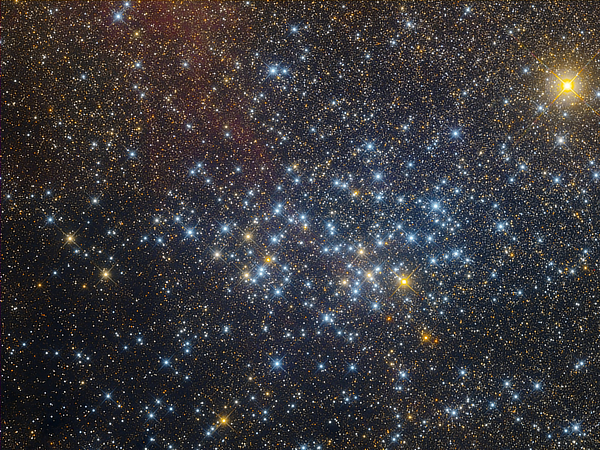NGC 3532 in Carina
March 2023 - Nebula and Cluster of the Month
Last month, I mentioned that this time of year is a poor one for open clusters and nebulae, the northern sky being dominated by the great galaxy fields of Leo, Coma and Virgo. This month is no different as far as the northern hemisphere is concerned, but things are very different in the southern hemisphere, where we must travel for this month’s object.
During summer, the rich Milky Way constellation of Carina lies high in the sky of the southern hemisphere. The southern Milky Way is richer and brighter than in the northern hemisphere because the Sun is located slightly north of the galactic plane meaning, simply, that there is more ‘below’ us than ‘above’. The galactic equator runs right through eastern Carina (close by Crux Australis) and our open cluster for this month, NGC 3532, lies in amongst this bewildering array of stars and nebulae.

NGC 3532 shines at magnitude three, so to claim that Nicolas-Louis de Lacaille ‘discovered’ it is an obvious fallacy. That he was the first European astronomer to catalogue its existence cannot be doubted. Lacaille travelled to South Africa in 1750 and remained there until 1754, making many important astronomical and geographical observations. He named several southern constellations, fourteen of which are still in use today.
His observation of what is now known as NGC 3532 was made in 1755 and published in the second of his three catalogues, originally having the designation Lacaille II.10. He describes it as a Prodigious cluster of small stars, very compressed, filling the figure of a semi-circle of 20 to 25 arc min in diameter.
John Herschel observed the cluster during his own sojourn in South Africa and was clearly impressed: A glorious cluster of immense magnitude, being at least 2 fields in extent every way. The stars are 8, 9, 10 and 11 mag, but chiefly 10 mag, of which there must be at least 200. It is the most brilliant object of the kind I have ever seen.
This is the closest you can get to saying that this is the best open cluster in the sky.
When Herschel’s deep-sky discoveries were condensed into the General Catalogue in 1864, the description was reduced to !! Cluster, extremely large, rich, little compressed, stars 8...12
which remained unchanged for the New General Catalogue of 1888.
The Trumpler classification is almost universally given as II3r, meaning that the cluster is detached from its background but with only a small degree of central condensation, there is a wide range of magnitudes amongst the member stars and that it is rich (more than 100 stars). The diameter is quoted as being between 50 and 60 arcmin, making it twice the diameter of the full moon.
The number of stars is (as always) a matter of much disagreement. The Deep-Sky Field Guide to Uranometria gives 150 members whilst Archinal & Hynes, with their usual precision, give 677. In a paper published in Astronomy & Astrophysics in 2019, Fritzewski et al.1 describe their work to characterise 2230 stars within 17deg; of the centre of NGC 3532, and find a preliminary membership of the cluster of 660 stars, with a confident prediction that the reality probably lies in excess of 1000, readily admitting that their survey is incomplete as they inspected no stars below magnitude 19.1. The Sun would be magnitude 18.2 at that distance.
The distance to open clusters is also frequently a matter of some contention. Archinal & Hynes confidently quote 478pc (1559ly). The European Southern Observatory, in their release of a colourful image of the cluster, quote 1300ly. The authors of the above-mentioned Astronomy & Astrophysics paper independently determined a distance of about 484pc (1578ly). These values are all broadly in agreement.
The age of the cluster has been determined by several authorities to be 300±50 million years.
All the stars in an open cluster form at the same time (on a cosmological scale). Therefore, they make excellent laboratories for studies of stellar evolution. Being relatively close and having a rich population, NGC 3532 is an exceptionally fine example. The stars are all the same age, yet we see a wide variety of types. There are Sun-like stars, red giants, white dwarfs, everything in-between and almost certainly many red dwarfs, though these would be exceptionally faint.
The difference is caused by the initial mass of the stars. The more massive a star, the more quickly it will evolve.
Visually, NGC 3532 is stunning. I have not seen it through a telescope, though I have seen it through binoculars from the pristine skies of the Australian Outback. To the naked eye, it appears as a bright smudge, stretching to the west of 3.9 magnitude V382 Carinae. Binoculars show a large cloud of stars, several of which stand out as orange in colour. The whole cluster sparkles. This area is fabulous in binoculars. Open clusters abound and less than 3° away is the fantastic η Carinae nebula, which shows its huge V-shaped dark lanes even in 10x50 binoculars.
| Object | RA | Dec | Type | Magnitude |
|---|---|---|---|---|
| NGC 3532 | 11h 05’ 45” | -58° 43’ 41” | Open cluster | 3.0 |
References:
- Astronomy & Astrophysics, Volume 622, February 2019